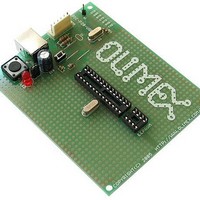PIC-P28-USB Olimex Ltd., PIC-P28-USB Datasheet - Page 2

PIC-P28-USB
Manufacturer Part Number
PIC-P28-USB
Description
MCU, MPU & DSP Development Tools PROTOTYPE BRD ICSP/ ICD ENABLED 28 PIN
Manufacturer
Olimex Ltd.
Datasheet
1.PIC-P28-USB.pdf
(8 pages)
Specifications of PIC-P28-USB
Processor To Be Evaluated
28 Pin PIC Devices
Interface Type
USB, ICSP
Dimensions
100 mm x 80 mm
Operating Supply Voltage
3.3 V, 5 V
Tool Type
Prototyping Board
Core Architecture
PIC
Cpu Core
PIC
Data Bus Width
8 bit
External Height
80mm
External Width
100mm
Mcu Supported Families
PIC-P28
Rohs Compliant
Yes
Lead Free Status / RoHS Status
Lead free / RoHS Compliant
Other names
1776341 52R3657
INTRODUCTION:
PIC-P28-USB board was designed in mind to create board which to
allow easy interface for your embedded projects to computers with
USB. It’s based around the popular FTDI chips FT232.
Some of you will say: wait a minute why to use additional expensive
chip to interface my PIC to USB when I have seen on Microchip’s web
site that there are PICs with buid-in USB controller as peripheral?
Here is the catch: USB (Universal Serial Bus) was created by the big
boys: Microsoft, Intel, NXP, HP, NEC (you can find more info at
www.usb.org) and it’s really great way to add peripherals to PC
computers as it carry both data signals and power supply, but as it’s
universal the programming of USB device is not easy job. The USB
interface is simple host-device interface. On the PC there is HOST
controller which provide the power and make the communication, but
because on the USB there are so many type of peripherals which are
supported like: Human interface devices – like mouse, joysticks,
tablets etc, Communication Devices like modems, links, routers etc.,
Image devices – like scanners, web cameras, etc, Mass storage devices
like hard drives, flash memories etc, Audio devices like microphones,
and speakers, you can imagine that writing the USB host controller
software is not easy job and there are several programming layers for
the USB stack i.e. host your application code will have the access to
the different peripherals. So one USB host stack may consist of many
tenths of thousands for high level language code.
At the USB device side the code is not so complicated as at least you
implement not all communication protocols for the devices mentioned
above, but only your device code, but it’s still not small code, and why
you should spend your time to write 1000 lines of code when you want
to make simple old good RS232 send and receive byte??? No much
sense I guess, but wait there is another catch when you plug the USB
device the host assign it an number which is used later to distinguish
it from the other USB devices connected to the computer. To make
the driver installation easier every USB product manufacturer should
have his own assigned VENDOR-CODE so far so good, this means when
you plug your Genius web camera Windows know which driver to
install. The bad for you is that to get this VENDOR-CODE you have to
pay US $1500.00 to USB.ORG guys, not bad business at all huh? To
sell numbers? If you decide to make thousands of USB devices it’s
good idea to have such vendor code, but what if you want to make one
small prototype which you want to connect to USB?
Now after reading all above you should not be surprised that FTDI Inc.
who created USB to RS232 chip FT232 is very popular – they give you
simple solution to connect to USB without knowing all the stuff behind
it, without paying upfront for USB vendor code and using the good old
fashioned RS232 way to program in your PIC. On their web there are
drivers for Windows version XYZ, Linux, Mac OS etc., so you can
interface your project to machines running all these operating systems
with small piece of code in the PIC.
PIC-P28-USB have FT232 USB-to-RS232 converter IC on board.
The power is taken from the USB so no need for external power supply
adapter. Note that when you plug your USB cable there is process of
USB enumeration and the power supply to PIC is supplied only when
USB host successfully enumerate your PIC-P28-USB so power to PIC
come with 1-2 seconds delay


















